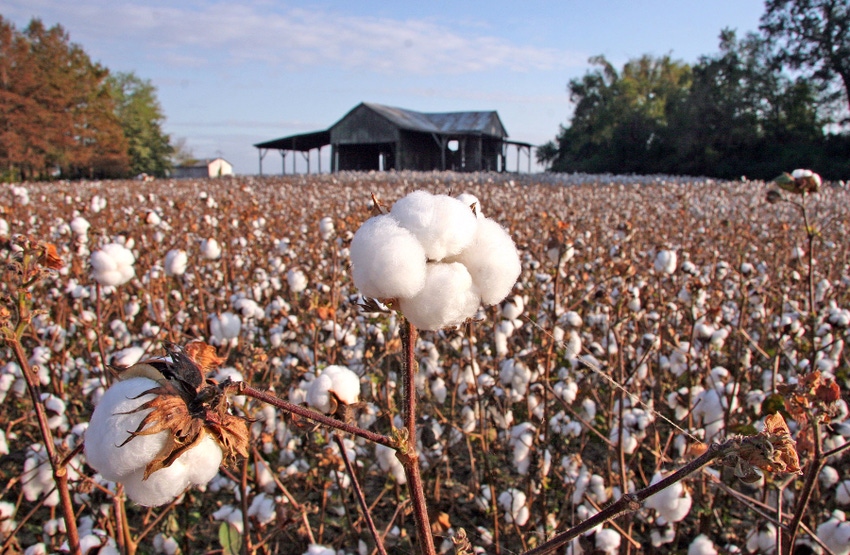
Cotton quality: high marks in 2011
The percentage of the 2011 cotton crop measured at base quality or higher was the highest in five years, according to USDA's Agricultural Marketing Service.The crop also hit high marks for average strength and staple length.The classing report was released with about 94 percent of the 2011 crop classed.

Mother Nature threw everything but the kitchen sink at the U.S. cotton crop in 2011, but producers did manage to produce a high-quality crop relative to past years, according to USDA’s Agricultural Marketing Service.
The percentage of cotton at base quality or higher was the highest in five years, according to Robbie Seals, director, USDA-AMS, Grading Division, Cotton and Tobacco Programs. The crop also hit high marks for average strength and staple length. The classing report was released with about 94 percent of the 2011 crop classed.
Seals noted that for most seasons, Texas produces the bulk of the U.S. cotton crop, but last season, due to extensive drought, the Texas share fell from nearly 50 percent to around 25 percent.
Ninety-three percent of cotton graded had a color grade of 41/32 or higher, which was unchanged from last year, according to Seals. It remained fairly consistent across regions except in the Southeast (84.6 percent at 41/32) where the effects of a fall hurricane impacted quality in North Carolina and Virginia. The percentage with a 41/32 color grade was over 95 percent in all other areas.
Average leaf grade was up slightly from last year across the United States, rising from a 2.8 to a 3.0, according to Seals. “It was lower for the Southeast, going from a 3.4 to a 3.2. We were up in the Mid-South, from a 3.3 to a 3.5, but that still was not as high as it was in 2009. The Texas crop was much cleaner due to the effects of drought, while the Desert Southwest and California leaf grades were unchanged from the previous year.”
Percent extraneous matter was up from 2010, rising from a 3.7 to a 6.0. By region, Texas recorded the highest percentage, at 15.3 percent, followed by the Southeast, at 4.5 percent. “We did see more problems in seed coat fragments in 2011,” Seals said. “In Corpus Christi and Abilene, we had classed as much cotton with seed coat fragments by mid-September as we classed for the entire season the year before. The drought may have impacted that. We did have some seed coat fragments in Louisiana and into the Southeast too.”
Average micronaire for the United States was a 4.6, according to Seals, which was not significantly different from the previous year. By region, average micronaire fell from the previous year in the Mid-South and Southeast, and rose in all other regions.
Average strength tied a record achieved the previous year, according to Seals. “Ever since we went to 100 percent High Volume Instrument classing, we have continually increased the strength average. The last two years, we’ve had the highest strength average ever, at 30 grams per tex. That’s a little surprising because the Texas crop, which had increased its strength quite a bit in recent years, fell slightly this year.”
The Mid-South cotton crop recorded an average strength of almost 31 grams per tex, while the Southeast remained the same as last year. at 29.4.
For the third year in a row, average staple length was 35.5. By region, staple length was longer than the previous year in the Southeast and the Mid-South, and fell in other regions.
Beginning in 2005, Texas staple has annually passed the national average. But it made a significant drop in 2011, noted Seals, “certainly due to the drought conditions.”
The percent of cotton at base quality and higher was 59 percent, the highest in the last five years, according to Seals. “By region, the percentage was up significantly in the Southeast and the Mid-South, but was down in Texas and the Desert Southwest and up in California.”
The Southeast might have recorded an even higher percentage at base quality if not for the effect of hurricanes on two states, according to Seals. “Alabama, Florida, South Carolina and Georgia had big increases in the percent of cotton at base quality, while North Carolina and Virginia both took hits.”
The percent of cotton at high quality (31-3-35, 3.5-4.9 micronaire and no extraneous matter) rose significantly for Alabama and Georgia (to over 30 percent), according to Seals. “Texas dropped significantly from the previous year (from 55 percent to 35 percent), but was still above the 2009 crop.”
The percentage of high-quality cotton was higher for Arkansas, Missouri, Mississippi and Louisiana, but declined to below 30 percent for Tennessee.
American Pima at Grade 3 and higher was 96.7 percent, a slight increase over the previous year. Average micronaire for Pima rose slightly, to 3.9, while strength rose a full gram per tex, to 42.6, from the previous year.
About the Author(s)
You May Also Like





